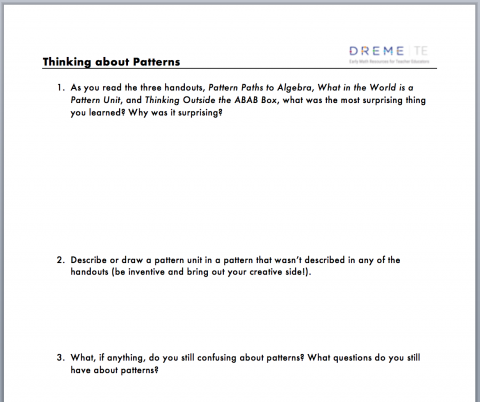As a pre-service teacher educator working with students who are just beginning their preschool teaching careers, I have three main goals: (1) help students draw on their own experiences in mathematics, good and bad, to create supportive mathematical learning environments for preschool children; (2) support students in gaining knowledge about early mathematical development; and (3) help students learn how to engage young children in rich mathematical activities.
Preschool Curriculum Course: Three Hours
These guidelines can provide 3 hours of in-class instruction on patterns in a preschool curriculum course or a stand-alone session, or a session in a series of professional development workshops. It is broken into two segments, but can be broken into shorter segments.
Readings (preparation homework for students)
Classroom Activities
- Pre- and in-service teachers may themselves struggle to understand the concept of a pattern unit, and consequently find it difficult to support children’s understanding of the concept. The activities provide opportunities to engage in readings on pattern units and think about how classroom interactions can support children’s learning.
- Have participants break into small groups and provide them with the Thinking about Patterns worksheet (download below). Provide about 20 minutes to answer the questions on the worksheet. Members of each group can answer individually or on a common worksheet.
- Have small groups share out to the whole group. Be prepared to answer (or find the answers) to questions they might pose to question #3 (What, if anything, is still confusing about patterns?). Remember that drawing on the expertise in the whole group is often a way for participants to feel empowered in their own knowledge. Posing or reframing a participant’s confusion or question about patterns to the whole group can be one of the best ways of increasing knowledge across the classroom.
- Implement the Teaching Algebraic Thinking to Young Children activity with participants working in small groups. The activity should be set up as an exploration into patterns, where the emphasis is on the process of solving the problems (not the answers themselves). Actively circulate to allay concerns and frustration if they occur.
- End the session by asking participants to share insights gained during the session and any remaining questions about patterns (or other mathematical concepts or pedagogy).

